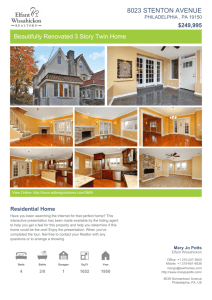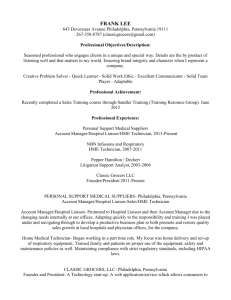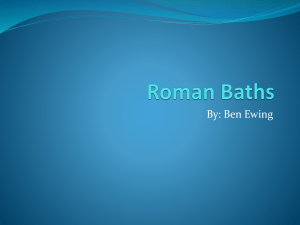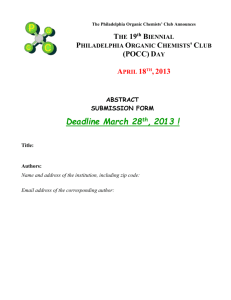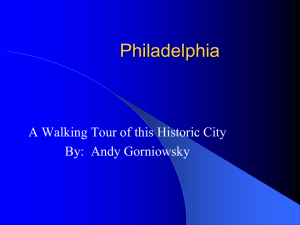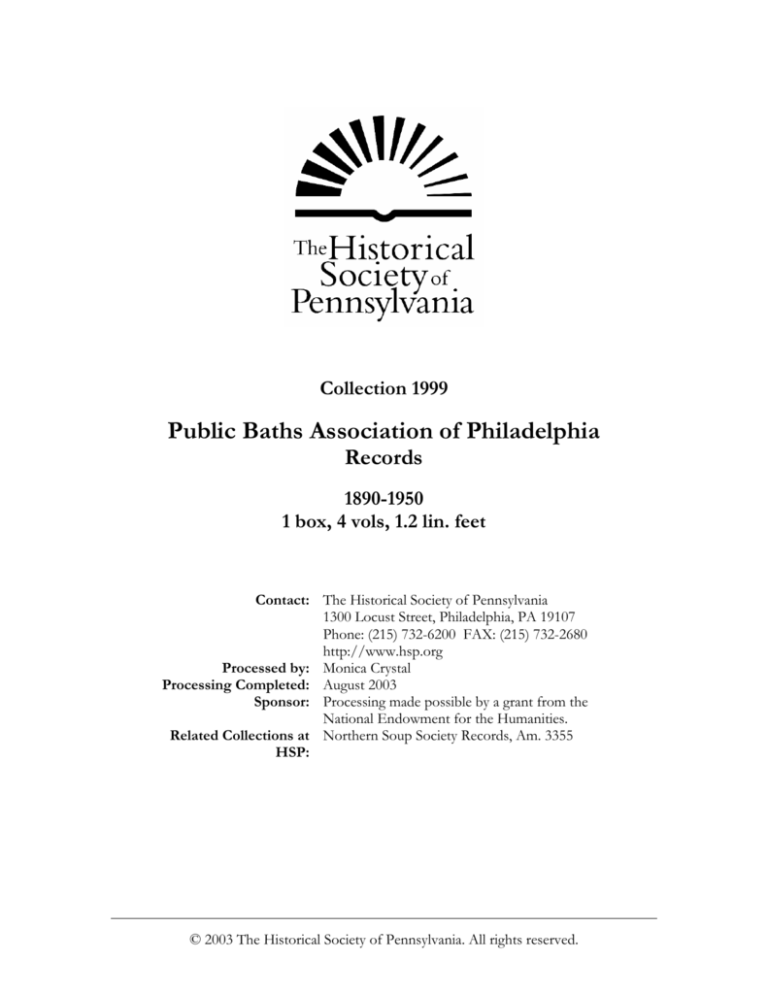
Collection 1999
Public Baths Association of Philadelphia
Records
1890-1950
1 box, 4 vols, 1.2 lin. feet
Contact: The Historical Society of Pennsylvania
1300 Locust Street, Philadelphia, PA 19107
Phone: (215) 732-6200 FAX: (215) 732-2680
http://www.hsp.org
Processed by: Monica Crystal
Processing Completed: August 2003
Sponsor: Processing made possible by a grant from the
National Endowment for the Humanities.
Related Collections at Northern Soup Society Records, Am. 3355
HSP:
© 2003 The Historical Society of Pennsylvania. All rights reserved.
Public Baths Association of Philadelphia
Records, 1890-1950
1 box, 4 vols., 1 lin. ft.
Collection 1999
Abstract
The Public Baths Association of Philadelphia (PBA) was a private charitable organization
founded in 1895 to provide inexpensive bathing and laundry facilities to “the selfrespecting poor” in working-class neighborhoods of Philadelphia. The association
opened the first of its six bathhouses in 1898 and its last in 1928. PBA disbanded in
1950.
Records of the Public Baths Association of Philadelphia consist of a trustees’ minute
book, 1902 to 1950; three scrapbooks, 1898 to 1944, which contain posters,
advertisements, and postcards; annual reports; records of the association’s real property,
1890 to 1944; and three photographs.
Background note
The Public Baths Association of Philadelphia (PBA) was a private charitable organization
founded in 1895 to provide bathing and laundry facilities for the city’s working poor.
The baths offered an alternative to city pools, which were strictly for recreation and open
only during the summer months. The PBA erected six bathhouses in densely populated
areas where fewer than one in twenty poor working class families could bathe at home.
Sarah Dickson Lowrie proposed the idea of the Public Baths Association at a dinner
party hosted by John Wanamaker. Lowrie was one of a group of wealthy social
reformers seeking to improve the sanitary conditions of the working poor. The group
researched the idea of a public bathhouse by visiting successful operations in New York
City and London and concluded that the enterprise could succeed in Philadelphia. They
submitted a certificate of incorporation to the Court of Common Pleas and gained
approval on March 18, 1895. The Public Baths Association of Philadelphia, governed by
a board of twelve trustees, came into being. The first house opened in 1898, to public
acclaim. Between 1898 and 1928, five additional bathhouses arose in other densely
populated sections of the city.
According to its charter, the association was formed “for the purpose of establishing and
maintaining public baths and affording to the poor facilities for bathing and the
promotion of health and cleanliness.” The corporation had no capital stock and was
1
The Historical Society of Pennsylvania
Public Baths Association of Philadelphia Records
Collection 1999
largely funded by donations and subscriptions. In 1895, the Board of Trustees included
Eugene Delano, president; Charles Brinley, vice president; Sarah D. Lowrie, secretary;
and Franklin B. Kirkbride, treasurer. In 1905, Kirkbride would be awarded a silver medal
at the International Exposition in Liege, Belgium, for his personal interest and efficient
promotion of the baths. In addition to Kirkbide’s medal for personal achievements, the
association itself also received a gold medal.
The first bathhouse opened in April of 1898, on property at 410-412 Gaskill Street,
which the association purchased from Elizabeth W. Ridgway. A Public Improvements article
commented, “On April 21st, 1898, Congress declared war against Spain, and the Public
Baths Association of Philadelphia declared war against uncleanliness by opening the
doors of the Gaskill Street baths.” The Philadelphia Medical Journal observed that “it was
Pliny who said that Rome needed no medicine but the public baths.”
The bathhouse provided separate facilities for men and women. Ladies showered or
bathed on the second floor and washed and dried their clothes in the basement laundry.
Gentlemen entered their bath on the first floor and had access to the laundry only on
weekends. A five-cent admission fee entitled the patron to use a private shower for half
an hour.
In 1902, the next bathhouse was opened at 413-415 Gaskill Street, across from the first
operation. This new bathhouse was exclusively for women. Donors gave della Robbia
plasters and reproductions of famous artwork to decorate the walls. The association’s
first annual report listed boxes of soap from Fels and Company, as well as brooms,
washboards and mirrors from Lit Brothers, among its donations.
The success of the Gaskill Street bathhouses prompted the PBA to choose a third
location at 718 Wood Street. Press clippings from February 15, 1902, advertised a
performance of “The Paper Chase,” a comedy in three acts, for the benefit of the Wood
Street site. The cast included several prominent Philadelphians described in the social
pages as “competent amateurs.” The playbill listed such sponsors as Schreiber & Kerr
Tailors; J. E. Caldwell; and Wm. Bryant Coal, Wood & Coke.
In 1910, another facility opened at 1203-1205 Germantown Avenue. The cost of the
building was $7,000 and the lot $4,800. The fifth bathhouse was built in South
Philadelphia at Passyunk Avenue and Wharton Street and opened in March, 1922. In
1928, the sixth bathhouse was erected in Kensington, at 1808-1814 Hazzard Street.
In 1932, the PBA’s 35th Annual Report advocated the needs of the poor during the
Depression. Donor letters solicited funds to cover rising costs caused by the slump and
increased unemployment. For the next several years, the association recorded a
continuing deficit while their conservative spending during this period created a backlog
of repairs and renovations of the facilities.
During the Second World War, the city saw a dramatic leap in jobs. While there was a
greater need for the baths, rising costs and mounting repairs forced the board to sell the
2
The Historical Society of Pennsylvania
Public Baths Association of Philadelphia Records
Collection 1999
Gaskill bathhouse. On July 16, 1945, plans went ahead to sell the Hazzard property as
well.
At a special meeting of the board on October 10, 1946, a number of issues were
addressed. The board authorized the sale of the Wood Street site. An audit disclosed a
discrepancy in collecting and depositing bathhouse receipts and the superintendent was
relieved of his duties. He was later reinstated in another capacity after he made full
reparations and it was determined that he had made poor decisions rather than a
calculated act to embezzle funds. At that same meeting, the board determined that it
would be appropriate to have the PBA cease operation as a charity if satisfactory
arrangements could be made to dispose of the remaining properties. A committee of
three members consulted with the Council on Social Agencies of the Community Fund
of Philadelphia. The council surveyed the Public Baths Association to determine its place
in the needs of the community and concluded that there was no longer a charitable need
for the bathhouses.
In April 1948 the Germantown and Passyunk properties were condemned by the city of
Philadelphia, and there were no satisfactory offers made to purchase them. On October
30 of that year, the remaining bathhouses were shuttered and all active operations
ceased. A final determination was made for disposing of the association’s assets to the
Philadelphia Foundation. The last recorded meeting of the Public Baths Association of
Philadelphia was held on January 11, 1950.
Scope & content
Records of the Public Baths Association span almost the entire history of the
organization. The minute book begins in 1902, several years after the association was
formed. While not a complete run of the association’s minutes, the minute book does
include information on the organization’s founding, as well as decision-making and fundraising efforts of the trustees. Yearly and special meetings offer insight into the board’s
philosophy, motivations and decisions. It does not include records of subscribers or
patrons.
The real estate records include documents regarding contract negotiations, property
evaluation, bathhouse management, and personnel issues, which grew more complex as
rising costs, inflation and labor disputes became more prevalent in the mid-1900s.
Scrapbooks chronicle the association’s public outreach, and reflect the philosophy that
all citizens should be woven into the social fabric, from the highest to the lowest classes
of society. The three books contain a liberal amount of association advertisements
including colorful and interesting brochures, leaflets, and advertising cards. Numerous
press clippings and several letters from trustees reflect the unceasing effort to promote
the bathhouses and make the public aware of good hygiene.
3
The Historical Society of Pennsylvania
Public Baths Association of Philadelphia Records
Collection 1999
Overview of arrangement
Series I
Series II
Series III
Administrative, 1890-1950
a. Trustees’ minutes, 1902-1950
b. Real estate, 1890-1944
c. Miscellaneous, 1920-1950
Scrapbooks, 1895-1944
Photographs, n.d.
1 box + 1 vol.
1 vol.
7 folders
2 folders
3 vols.
1 folder
Series description
Series 1. Administrative, 1890-1950 (Box 1, vol. 1)
a. Trustees’ minutes, 1902-1950.
This volume contains the typed minutes of regularly scheduled and special meetings
of the twelve members of the Board of Trustees from October 3, 1902, to January
11, 1950. These meetings were the starting point of all of the organization’s projects.
The minute book is not a complete run of meetings but does give a comprehensive
view of business discussions and decisions made concerning the selection of sites,
acquisition of properties, contractors hired, price negotiations, fund-raising
strategies, board members elected, and resignations accepted. Also recorded in the
minutes are reports of the superintendent on the physical status and needs of the
facilities. A lengthy March 10, 1905, example details discussions concerning the
purchase of two 50-horse power horizontal tubular boilers for the Gaskill Street
bathhouse at a cost of over $2,000.
b. Real estate, 1890-1944.
Papers in this subseries document actions taken in response to decisions made at the
trustees’ meetings. Materials include mortgages, deeds, title insurance policies,
contractor’s bonds, legal opinions, miscellaneous letters, and receipts.
c. Miscellaneous, 1920-1950.
This subseries includes a 1932 copy of PBA’s charter, letters to and from the Public
Baths Association and the Internal Revenue Service concerning tax-exempt status a
typed history of the PBA, and a certified copy of the last will and testament of
Elizabeth B. Pickering, who bequeathed one thousand dollars to the PBA. Other
materials include an undated, hand-colored pamphlet issued by the Playground and
Recreation Association. The pamphlet discusses the limited opportunities available
to poor children and the importance of getting funding for playgrounds and clubs
where they could play safely. There is also a 1938 list of charities endorsed by the
Philadelphia Chamber of Commerce.
Series 2. Scrapbooks, 1895-1944 (vols. 2-4)
The series contains three scrapbooks, which are quite similar in content and layout.
There is a large quantity of news clippings on a variety of subjects such as bathhouse
openings, and a comparison between Philadelphia and London baths. There are
4
The Historical Society of Pennsylvania
Public Baths Association of Philadelphia Records
Collection 1999
postcards, cardboard signs, brochures, and leaflets of various sizes promoting the
baths. Some of the material is in color. Annual reports (1898-1902 and 1928-1944)
document the association’s early financial stability, as well as their eventual downturn
in the 1930s and 40s. There is also a playbill for a fund-raiser, “The Paper Chase,”
and several letters to and from officers of the association requesting donations.
Series 3. Photographs, n.d.
This series includes three undated photographs: one of the exterior of the Wood
Street bathhouse, another of several women doing laundry, and a third showing
bystanders at the corner of Gaskill and Leithgow Streets.
5
The Historical Society of Pennsylvania
Public Baths Association of Philadelphia Records
Collection 1999
Separation report
None.
Related materials
Northern Soup Society Records (call number Am .3355). The Northern Soup Society
also operated a bathhouse in Philadelphia.
Subjects
Charities – Pennsylvania – Philadelphia – 19th century
Charities – Pennsylvania – Philadelphia – 20th century
Depressions – 1929 – Pennsylvania – Philadelphia
Hygiene – Pennsylvania – Philadelphia – 20th century
Laundry – Pennsylvania – Philadelphia – 20th century
Philadelphia (Pa.) – Economic conditions – 20th century
Public baths – Pennsylvania – Philadelphia – 19th century
Public baths – Pennsylvania – Philadelphia – 20th century
Working poor – Health and hygiene – 20th century
World War, 1939-1945 – Economic aspects
Kirkbride, Franklin Butler, 1867-1955
Lowrie, Sarah Dickson, 1870-1957
Community Fund of Philadelphia
Playground and Recreation Association (Philadelphia, Pa.)
Public Baths Association of Philadelphia
6
The Historical Society of Pennsylvania
Public Baths Association of Philadelphia Records
Collection 1999
Administrative Information
Restrictions
The collection is open for research.
Acquisition information
Gift of Stephen R. Newman, 1972.
Accession 72:49
Alternative format
None.
Preferred citation
Cite as: [Indicate cited item or series here], Public Baths Association of Philadelphia
Records (Collection 1999), The Historical Society of Pennsylvania.
Processing note
Processing made possible by a grant from the National Endowment for the Humanities.
Any views, findings, conclusions, or recommendations expressed in this finding aid do
not necessarily reflect those of the National Endowment for the Humanities.
7
The Historical Society of Pennsylvania
Public Baths Association of Philadelphia Records
Collection 1999
Box and folder listing
Series 1. Administrative a. Trustees’ minutes
Folder title
Trustees’ minutes
Trustees’ minutes
Date
1902-1950
1950
Vol./Box
vol. 1
1
Folder
Box
Flat file
1
1
Flat file
Folder
1
Series 1 Administrative b. Real estate
Folder title
Real estate records
Real estate records
Real estate records
Real estate records
Date
1890-1903
1895-1898
1901-1905
1904-1923,
1942
1910-1911
1915-1916,
1923-1934
1930-1946
1942
1902-1933
1905, 1942
Real estate records
Real estate records
Real estate records
Plan of property
Bonds
Bonds
2
3
1
1
4
5
1
Flat file
1
Flat file
6
7
Series 1. Administrative c. Miscellaneous
Folder title
Copy of charter
Internal Revenue Service
correspondence
History of the PBA
Will of Elizabeth Pickering
Miscellaneous
Date
1932
1920
n.d.
1931
1938, n.d.
Box
1
1
1
1
1
Folder
8
9
10
11
12
Series 2. Scrapbooks
Title
Scrapbook
Scrapbook
Scrapbook
Posters
Date
1895-1902
1902-1929
1916-1944
n.d.
Vol./Box
vol. 2
vol. 3
vol. 4
Flat file
Folder
8
The Historical Society of Pennsylvania
Public Baths Association of Philadelphia Records
Collection 1999
Series 3. Photographs
Title
Photographs
Date
n.d.
Box
1
Folder
13
9
The Historical Society of Pennsylvania

